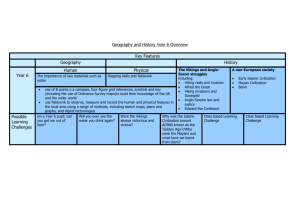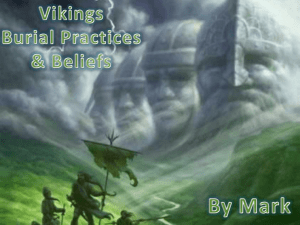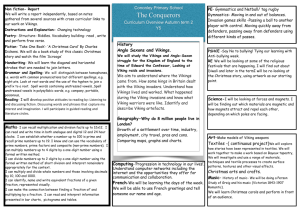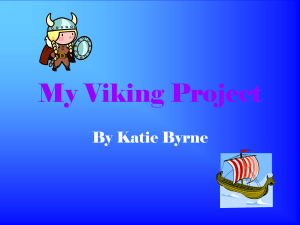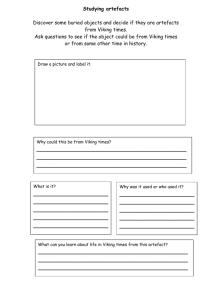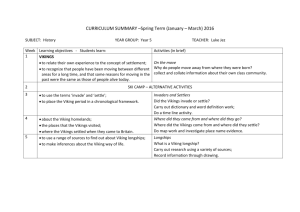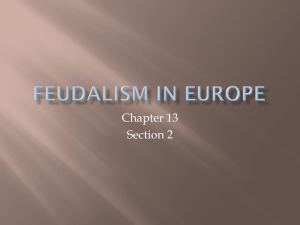Loot: Why the Vikings Came to Britain
advertisement
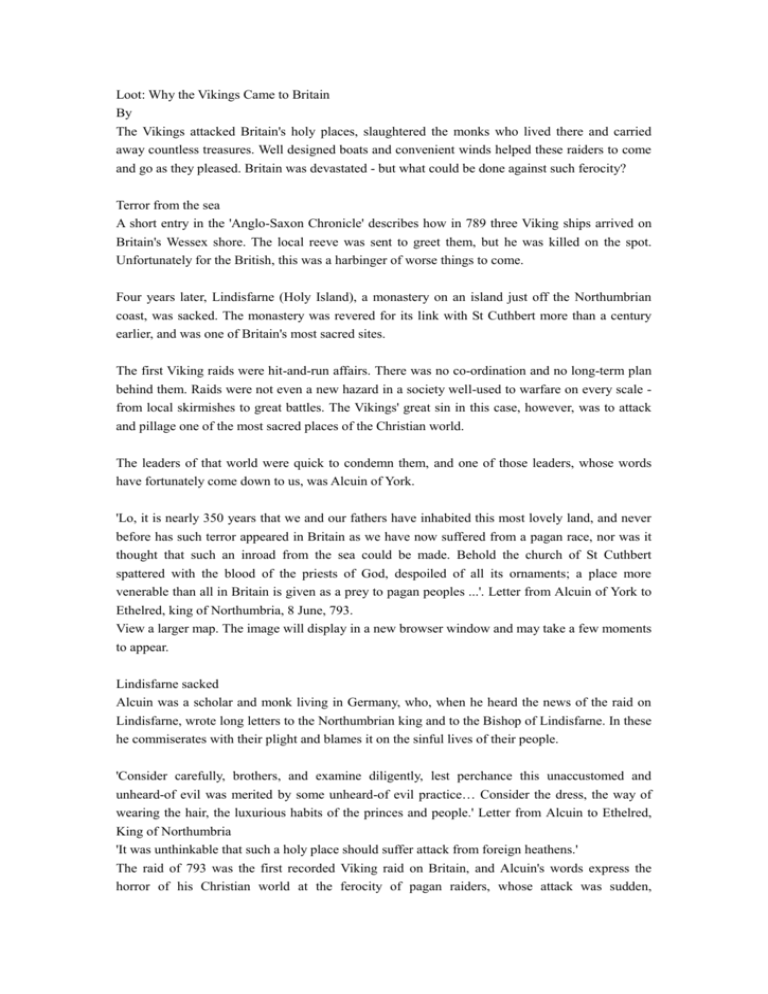
Loot: Why the Vikings Came to Britain By The Vikings attacked Britain's holy places, slaughtered the monks who lived there and carried away countless treasures. Well designed boats and convenient winds helped these raiders to come and go as they pleased. Britain was devastated - but what could be done against such ferocity? Terror from the sea A short entry in the 'Anglo-Saxon Chronicle' describes how in 789 three Viking ships arrived on Britain's Wessex shore. The local reeve was sent to greet them, but he was killed on the spot. Unfortunately for the British, this was a harbinger of worse things to come. Four years later, Lindisfarne (Holy Island), a monastery on an island just off the Northumbrian coast, was sacked. The monastery was revered for its link with St Cuthbert more than a century earlier, and was one of Britain's most sacred sites. The first Viking raids were hit-and-run affairs. There was no co-ordination and no long-term plan behind them. Raids were not even a new hazard in a society well-used to warfare on every scale from local skirmishes to great battles. The Vikings' great sin in this case, however, was to attack and pillage one of the most sacred places of the Christian world. The leaders of that world were quick to condemn them, and one of those leaders, whose words have fortunately come down to us, was Alcuin of York. 'Lo, it is nearly 350 years that we and our fathers have inhabited this most lovely land, and never before has such terror appeared in Britain as we have now suffered from a pagan race, nor was it thought that such an inroad from the sea could be made. Behold the church of St Cuthbert spattered with the blood of the priests of God, despoiled of all its ornaments; a place more venerable than all in Britain is given as a prey to pagan peoples ...'. Letter from Alcuin of York to Ethelred, king of Northumbria, 8 June, 793. View a larger map. The image will display in a new browser window and may take a few moments to appear. Lindisfarne sacked Alcuin was a scholar and monk living in Germany, who, when he heard the news of the raid on Lindisfarne, wrote long letters to the Northumbrian king and to the Bishop of Lindisfarne. In these he commiserates with their plight and blames it on the sinful lives of their people. 'Consider carefully, brothers, and examine diligently, lest perchance this unaccustomed and unheard-of evil was merited by some unheard-of evil practice… Consider the dress, the way of wearing the hair, the luxurious habits of the princes and people.' Letter from Alcuin to Ethelred, King of Northumbria 'It was unthinkable that such a holy place should suffer attack from foreign heathens.' The raid of 793 was the first recorded Viking raid on Britain, and Alcuin's words express the horror of his Christian world at the ferocity of pagan raiders, whose attack was sudden, unexpected and devastating. It was unthinkable that such a holy place should suffer attack from foreign heathens, that its monks should be slaughtered and its treasures taken. Yet this was to happen again and again to other monasteries throughout England, Wales, Scotland and Ireland. Alcuin's letters are just one piece of historical evidence for Viking attacks. Other raids were recorded in the annals kept in monasteries at Iona and in Ireland - an entry for 794 in the 'Annals of Ulster' tells of '... devastation of all the islands of Britain' - while Columba's famous monastery on the Scottish island of Iona was pillaged the following year, and again in 802, in 806 and in 825. Nowhere was safe from the Vikings. Who were the Vikings We tend to think of the Vikings as a single phenomenal race of Scandinavian warriors, but the reality is more complex. Raids on the British Isles and the coasts of France and Spain were the work of Vikings from Norway and Denmark (Swedish Vikings set out across the Baltic Sea into Poland, Latvia, Lithuania and Russia). The word Viking means one who lurks in a 'vik' or bay, in effect, a pirate. The word 'Viking' has come to describe a whole new age in Europe between about 800 and 1150. This is despite the fact that Vikings were not just pirates and warriors but also traders and colonists. But at the start of the Viking Age in the last decade of the eighth century, loot and adventure were the main goals of the Norwegians who raided in Scotland and Ireland, and of the Danes who attacked England. Gold and silver treasures accumulated by the great monasteries could be converted into personal wealth, and thus power, and captives could be sold as slaves. What better way for the young sons of good families to earn their way and see the world? '... examples of ... the 'work of angels' were looted and taken home by Vikings.' The monks who recorded these activities could not know the origins of their tormentors, but discoveries of precious metalwork from Britain in Norway and Denmark are clues to where the Vikings came from. Decorative mounts from church plate such as the Ardagh Chalice could be removed and made into brooches, the rest of the chalice melted down and the silver re-used. Such pieces have been found in pagan graves of around 800 in Scandinavia. The Ardagh Chalice escaped this fate, but many other beautiful examples of what has been called the 'work of angels' were looted and taken home by Vikings. One exquisite reliquary box, made in the eighth century to hold a saint's relic, became a Norwegian lady's jewellery casket in the tenth century, when an inscription in runes was carved on its base - 'Ranvaik owns this casket'. Ships and navigation Successful raiding and adventures overseas required good fast ships, and that is exactly what the development of boat technology had provided for the Vikings by the eighth century. The use of a sturdy keel meant that a mast could be properly supported, and that boats could be sailed as well as rowed. Long sea voyages were possible, even if navigation was still a matter of watching the movement of the sun and of observing landmarks and seabirds. 'Vikings preferred not to spend the night at sea if they could avoid it...' We know what their ships looked like, because many Vikings were buried with their worldly goods, and sometimes this included their boat. The Gokstad ship found in a burial south of Oslo, in Norway, is the sort of warship to which the Viking raiders probably aspired - an elegant 23m (75ft) of curving oak planks that would skim the waves. Tree-ring dating has shown that this particular ship was built towards the end of the ninth century, but its efficient design was developed earlier. It was fast, flexible and, with its shallow draught, easy to beach. Few warlords would have been able to afford to send such a magnificent vessel to the grave, and no Viking boat of the size of Gokstad has been found in Britain. Smaller rowing boats could be spared for funerary use, though, and the most recent discovery of a boat-burial at Scar, in Orkney, contained a vessel some 7m (23ft) long. But the existence of large warships in British waters can be inferred from the historical evidence - Vikings preferred not to spend the night at sea if they could avoid it, and would rather camp in tents on shore. A fair wind for raiding Alongside the efforts of boat builders was a gradual improvement in climate and overall weather patterns in the ninth and tenth centuries. This led to calmer seas and fewer storms in summer. There are many clues that point to this change in climate. If you slice a tree trunk horizontally, you can see the rings that represent annual growth - thick rings in good years and thin rings in bad years. Equally, if you dig down into a peat bog, you will find that there are horizontal layers, caused by variations in climate - in dry summers the surface of the bog will dry out and compact, whereas high rainfall will encourage the peat to grow. Plants can also provide evidence. They have different needs in terms of temperature and moisture, and the presence or absence of the pollen of certain plants on an archaeological site can indicate what the climate was like when people were living there. A cool and wet climate, for instance, will encourage the growth of ferns. So we know that the summers were getting warmer at the time of the Viking raids, but that was not the whole story. For Norwegians intent on reaching Scotland and the honeyed seaway to Ireland, the wind was on their side too. The prevailing winds helpfully blew westwards into their sails in springtime, to take them to the Scottish islands, and eastwards in the autumn to bring them home. The need for land Raids and loot were not the whole story. Land to farm was also a desirable commodity, especially for the families along the western seaboard of Norway, where fertile land was in short supply. Younger sons, political exiles, mercenary warriors and traders all had the option of becoming colonists in the lands now familiar from the tales of returning raiders. Once based in the northern and western islands of Scotland, they could farm and trade and still turn their hand to raiding whenever convenient. And we know from the 12th-century Icelandic Sagas that this is exactly what they did. Svein Asleifarson lived on the island of Gairsay in Orkney in the 12th century, and his lifestyle was recorded in one of these sagas. 'This was how Svein used to live. Winter he would spend at home on Gairsay, where he entertained some eighty men at his own expense. His drinking hall was so big, there was nothing in Orkney to compare with it. In the spring he had more than enough to occupy him, with a great deal of seed to sow which he saw to carefully himself. 'Then when that job was done, he would go off plundering in the Hebrides and in Ireland on what he called his "spring-trip", then back home just after mid-summer, where he stayed till the cornfields had been reaped and the grain was safely in. After that he would go off raiding again, and never came back till the first month of winter was ended. This he used to call his "autumn-trip".' Orkneyinga Saga, chapter 105 'Protection money had been extorted from the English.' The pattern of Danish colonisation in England was more organised, as had been Danish raids after about 850. In that year a Viking army had spent the winter encamped on the Isle of Thanet at the mouth of the River Thames, and protection money had been extorted from the English. Large forces of warriors, winter camps and payments in silver or food became the norm, even deep inland - a Viking camp of 873 has been excavated at Repton in Derbyshire. In 876 a Viking leader shared out the farmlands of Northumbria amongst his warriors. The Danish colonisation of England had begun. About the author Dr Anna Ritchie is an archaeologist and a Viking specialist. She has excavated numerous sites, notably Buckquoy, in Orkney. She is author of Viking Scotland, as well as many other books on Scottish archaeology.

